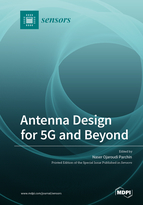Antenna Design for 5G and Beyond
A special issue of Sensors (ISSN 1424-8220). This special issue belongs to the section "Communications".
Deadline for manuscript submissions: closed (31 March 2021) | Viewed by 55935
Special Issue Editor
Interests: MIMO/diversity antennas; 5G/6G antennas; MM-wave phased arrays; multi-band/UWB antennas; RFID antennas; metamaterials and metasurfaces; Fabry resonators; fractal antennas; band-pass/band-stop microwave filters; reconfigurable structures; power amplifiers; electromagnetic wave propagation
Special Issues, Collections and Topics in MDPI journals
Special Issue Information
Dear Colleagues,
With the rapid evolution of the wireless communications, fifth-generation (5G) communication has received lots of attention from both academia and industry, with many reported efforts and research outputs and significant improvements in different aspects, such as data rate speed and resolution, mobility, latency, etc. In some countries, the commercialization of 5G communication has started, as well as initial research of beyond technologies such as 6G.
MIMO technology with multiple antennas is a promising technology to obtain the requirements of 5G/6G communications. It can significantly enhance the capacity of the system and resist multipath fading, and it has become a hot spot in the field of wireless communications. This technology is a key component and probably the most established to truly reach the promised transfer data rates of future communication systems. In MIMO systems, multiple antennas are deployed at both the transmitter and receiver sides. The greater number of antennas can make the system more resistant to intentional jamming and interference. Massive MIMO with an especially high number of antennas will reduce energy consumption by targeting signals to individual users utilizing beamforming.
Apart from sub-6 GHz frequency bands, 5G/6G devices are also expected to cover millimeter-wave (mmWave) and terahertz (THz) spectra. However, moving to higher bands will bring new challenges and will certainly require careful consideration of the antenna design for smart devices. Compact antennas arranged as conformal, planar, and linear arrays can be employed at different portions of base stations and user equipment to form phased arrays with high gain and directional radiation beams.
Submission can focus on conceptual and applied research in topics including but not limited to:
- MIMO full-duplex antenna system;
- Decoupling of MIMO/diversity antennas;
- Massive MIMO antenna array for base station applications;
- Smartphone antennas;
- SAR and user impact on antenna performance;
- Phased array and beam-steerable antenna arrays;
- MM-wave and THz antennas;
- Beamforming and smart antennas for 5G and beyond;
- Metamaterial and frequency-selective surface (FSS)-inspired antennas;
- Reconfigurable antennas for 5G and beyond communications;
- Prototyping, measurements, and experimentation of 5G/6G antennas.
Submissions should be of high quality, suitable for an international journal, and should not have been submitted or published elsewhere. Additionally, extended versions of conference papers that show significant improvement (minimal of over 50%) can be considered for review to this Special Issue. Finally, we welcome review papers that cover the subjects of this Special Issue.
Technical Programme Committee members
- Professor Raed Abd-Alhameed, University of Bradford, UK
- Professor Peter Excell, Wrexham University, UK
- Professor Jonathan Rodriguez, South Wales University, UK
- Dr Mohammad Ojaroudi, Centre Inria - Lille Nord Europe, France
- Dr Issa Elfergani, Instituto de Telecomunicações, Averio, Portugal
- Dr Chan H See, Edinburgh Napier University, UK
Naser Ojaroudi Parchin
Guest Editor
Manuscript Submission Information
Manuscripts should be submitted online at www.mdpi.com by registering and logging in to this website. Once you are registered, click here to go to the submission form. Manuscripts can be submitted until the deadline. All submissions that pass pre-check are peer-reviewed. Accepted papers will be published continuously in the journal (as soon as accepted) and will be listed together on the special issue website. Research articles, review articles as well as short communications are invited. For planned papers, a title and short abstract (about 100 words) can be sent to the Editorial Office for announcement on this website.
Submitted manuscripts should not have been published previously, nor be under consideration for publication elsewhere (except conference proceedings papers). All manuscripts are thoroughly refereed through a single-blind peer-review process. A guide for authors and other relevant information for submission of manuscripts is available on the Instructions for Authors page. Sensors is an international peer-reviewed open access semimonthly journal published by MDPI.
Please visit the Instructions for Authors page before submitting a manuscript. The Article Processing Charge (APC) for publication in this open access journal is 2600 CHF (Swiss Francs). Submitted papers should be well formatted and use good English. Authors may use MDPI's English editing service prior to publication or during author revisions.







